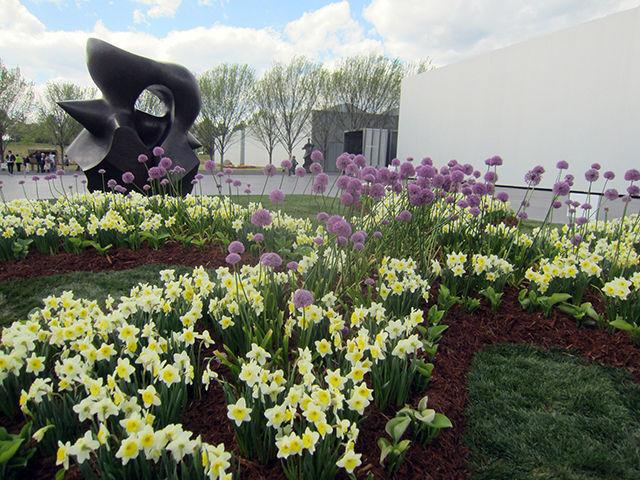 Professors and students from NC State’s Department of Horticultural Science worked to design and maintain a garden, inspired by the style of Henri Matisse, outside of the exhibit. The project required approximately eight months of work, planning and design." />
Professors and students from NC State’s Department of Horticultural Science worked to design and maintain a garden, inspired by the style of Henri Matisse, outside of the exhibit. The project required approximately eight months of work, planning and design." />
Contributed by Julieta Sherk
Professors and students from NC State’s Department of Horticultural Science worked to design and maintain a garden, inspired by the style of Henri Matisse, outside of the exhibit. The project required approximately eight months of work, planning and design.
The art and science of flower arrangements converged this weekend at the North Carolina Museum of Art’s Art in Bloom festival. Professors and students from NC State’s Department of Horticultural Science worked to design and maintain a garden, inspired by the style of Henri Matisse, outside of the exhibit.
This was the second annual Art in Bloom festival that incorporates the work of floral designers across North Carolina into the gallery. The festival raises money for the museum’s programming and education departments, along with welcoming spring through flowers and art.
The museum was filled with flower arrangements designed by artists from North Carolina, intended to match or mimic certain pieces of the galleries’ artwork through their color schemes, shapes and patterns. The arrangements stood near the work they were intended to mimic so that visitors could have the unique opportunity to compare and contrast the museum’s artwork with the floral artwork.
“We were looking for something joyful,” said Laura Finan, the project manager of Art in Bloom. “And this is definitely joyful. The individual florists each had their own emotional interpretation that they take from their work of art, but what we want is to make people happy.”
Outside, at the entrance to the exhibit, a garden was designed, grown and maintained with the help of professors and students at NC State. It includes yellow daffodils covering every inch of the bed with bulbs of purple alliums peeping up between them, surrounding a large modern stone statue. This project required approximately eight months of work, planning and design.
“All of the plants you saw out there are actually in pots. A garden like that would never happen if we had planted it in the ground,” said Julieta Sherk, an associate professor of landscape design in NC State’s Department of Horticultural Science, and a licensed landscape architect who was heavily involved with the project. “It’s all highly complex horticulture that went into making that magic happen.”
Sherk worked with her colleague August DeHertogh, a professor emeritus and former department head in the Department of Horticultural Science at NC State. His research and his two books, “The Physiology of Flower Bulbs” and “Holland Bulb Forcers Guide,” were instrumental in making, maintaining and growing of the garden.
“There is a lot of science behind this,” Sherk said. “Dr. DeHertogh wrote what he calls the bible and basically it’s the results of his lifetime of research. It’s like recipes. So he has tested and figured out what to do and how to do it with bulb forcing.”
Bulb forcing is a process for maintenance and storage of flower bulbs that the team used for the project in NC State’s greenhouses. The Allium bulbs began their journey in the Netherlands, and arrived and were planted in the United States in November. They were then moved to a greenhouse with low night temperatures in January. The potted flower bulbs were finally placed in the “Moore” statue bed at the NCMA April 4 with the assistance of NC State professors, students and Myatt Landscaping. Student involvement was important to the project, according to Sherk.
“I got a B.S. in biology, so I love the science and being with Dr. DeHertogh in a greenhouse and learning from him — these are things I would never do as a landscape architect,” Sherk said. “So infusing that more science-based information into my design classes has always been a goal. He came and lectured in my classroom and shared his knowledge and enriched my teaching with our collaboration.”
Sherk allowed her students to submit designs for the garden, but ultimately hers was chosen for the exhibit, drawing inspiration from Henri Matisse.
“I’m very highly influenced by Matisse, and I was imagining how later in his life he had arthritis and couldn’t paint so he would use cutouts that have an inkling of that form of what we’ll call a flower or a star,” Sherk said. “I even like to think of it as a splash. That is the spreading of exuberant colors, and I used complementary colors, the yellow and the violet, to make it even more dramatic.”